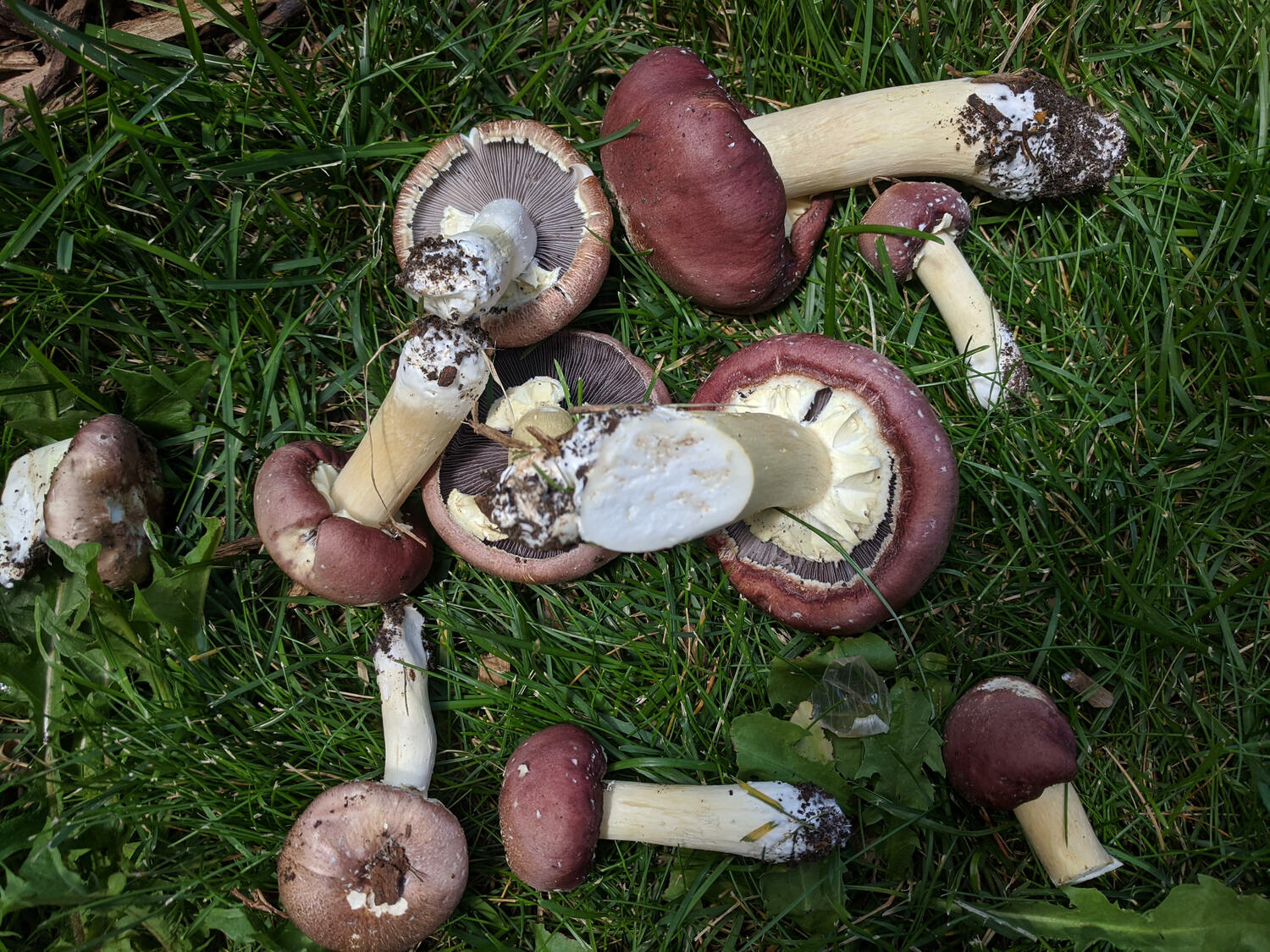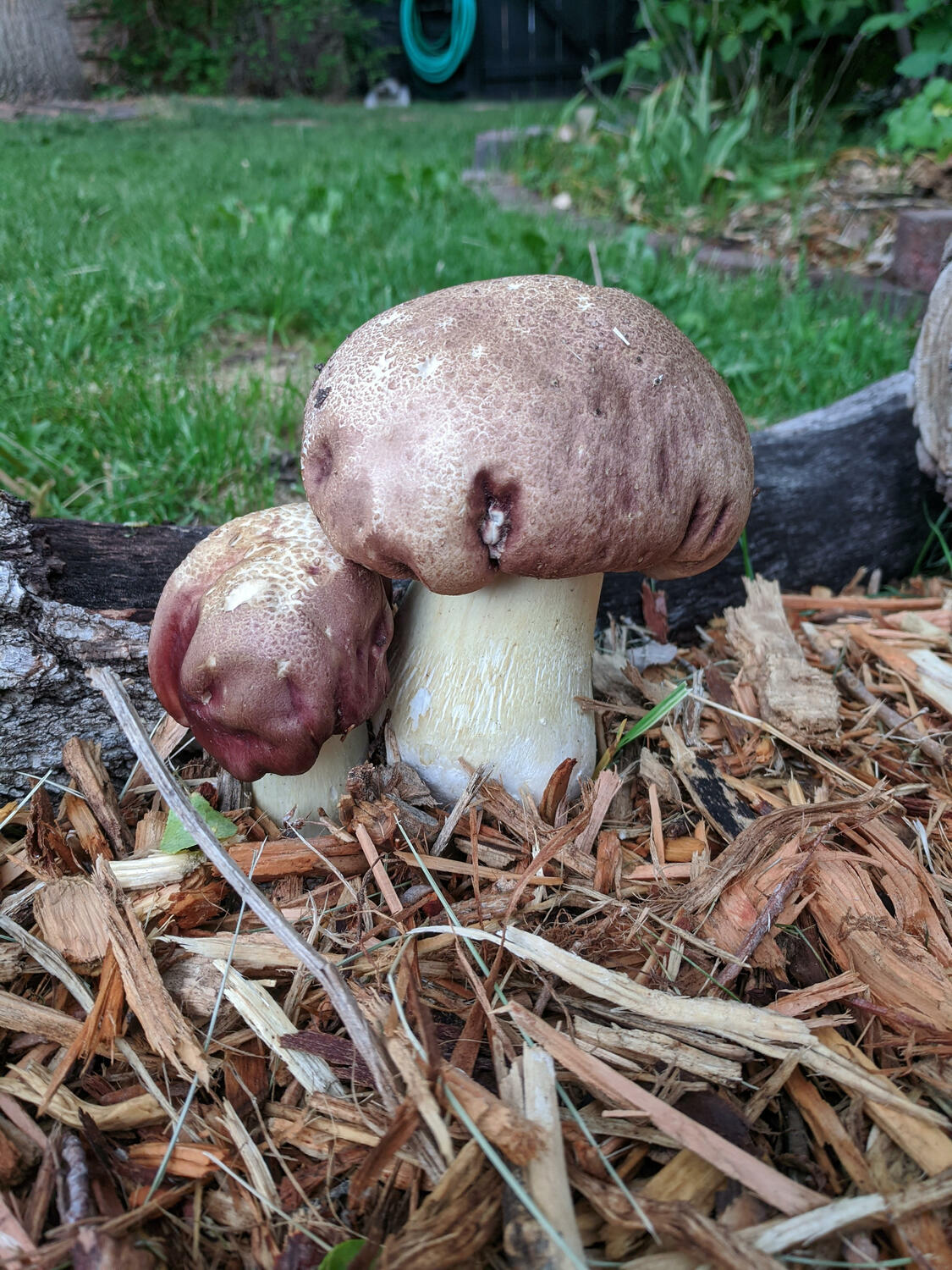
Cultivating Garden Giant Mushrooms

Photo courtesy of Ben Kinsley
"Garden giant" and "wine cap" are common names for Stropharia rugusoannulata. This mushroom is native to Europe but not invasive when introduced to soils here.
1. Storing Your Spawn Block(s)
Store your block(s) unopened in a cool dark place until you are ready to use them.
2. Building an Outdoor Bed
a. Choosing a Location
A good mushroom bed location has some shade and access to water. Although Stropharia mycelium can tolerate direct sunlight and summer heat, your mushrooms will retain more moisture and freshness if you provide them with some amount of shade.
You may also consider where the natural flow of water output is; a garden giant bed would be happy at the bottom of a slope or near a downspout. Regardless, it will need to be watered, so make sure your hose can reach it.
b. Gathering Substrate Materials
Minimum materials: plain (not shiny) cardboard, fresh hardwood chips and spawn. You may also use untreated dead leaves, coffee grounds, straw, food scraps, and other yard waste. Stropharia mycelium is extremely hardy and loves a microbially active environment.
c. Determining Bed Size
Decide how large you would like your beds to be. One spawn block can cover a 4 x 4 square foot area. The more space you cover, the more mushrooms you will get. You can also integrate your spawn into an existing garden bed; combine spawn + woodchips and spread it amongst your veggies.
d. Building the Bed(s)
Put down plain cardboard as a barrier. Then layer spawn, woodchips, and other substrate materials on top of it. If available, add a thick layer of straw to the finished bed to lock in moisture. Thoroughly water the bed immediately after installation and daily for two weeks. After that, weekly watering is sufficient.
e. Adding a Casing (optional)
After about 4-6 months your beds will be ready to fruit. You can tell by a good amount of white, stringy mycelium present when you pull up some woodchips from the bed. Around this time, some cultivators will add a thin layer of rich, microbially active compost, otherwise known as a casing, to their garden giant beds as a final nutrient boost. Stropharia is somewhat unique in this preference, and it is not entirely necessary, but you may want to experiment with it if you can.
f. Overwintering Your Beds
Come winter, cover your beds with a fresh layer of fresh wood chips and/or straw. This gives the mycelium cover, moisture and more food to grow on eventually. To help retain more moisture use burlap bags or tarp on top. Like with outdoor plants in the winter you want to water about once a month and more if there are consecutive warm days. The following spring, begin watering regularly again for another year of fruiting!
Note: Earth Worms
Worms love to munch on myceliated substrate. This is helpful for aerating soil and supporting overall soil health and plant life, but is not ideal for sustaining your mushroom patch. If it's an issue consider starting a new bed using some myceliated wood chips from your current one, and let the rest be digested by the earthworms and become rich myco-vermicompost.

Photo courtesy of Ben Kinsley
3. Harvesting, Storing & Cooking Your Mushrooms
Once your mushrooms begin to fruit, they will grow to full size within 3-5 days. Be sure to harvest them while they are fresh; otherwise, they may dry out, or, if it's rainy, become infested with bugs. Harvest by reaching all the way to the base of the mushroom and gently pulling up and to the side, separating the base of them mushroom from the mycelium. Trim any dirty spots with a knife and cook right away or store in the fridge for up to 10 days.
The stem of garden giant mushrooms is stringy and tough like asparagus. The caps are much softer and are great for making stuffed mushrooms. Overall, their flavor is umami and reminiscent of potatoes. They will go well in any dish or feature nicely as a main ingredient. Enjoy!
Other Resources: Check out this video from Mushroom Mountain, DIY Mushroom Cultivation by Willoughby Arevalo, or Organic Mushroom Farming and Mycoremediation by Trad Cotter.